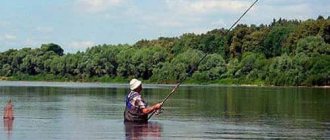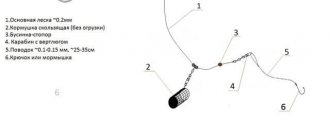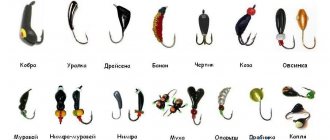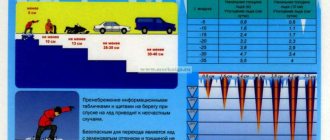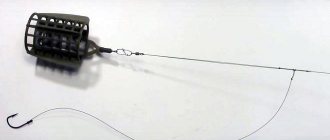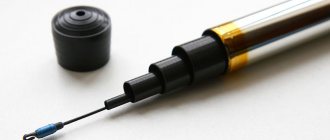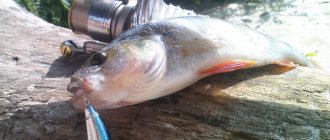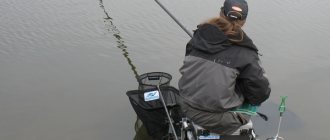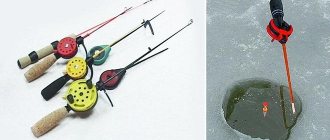Description and features of the lapdog
The tackle was invented in the Italian province of Bologna, where the most popular factory for the production of forms, Reglass, still operates. A modern Bolognese fishing rod consists of the following parts:
- Multi-legged telescopic blank made of glass or carbon fiber with a powerful reel seat. The optimal length is 5-8 meters.
- A good reel of inertial or non-inertial type, on which the main fishing line is wound.
- Float. As a rule, a sliding float is used in such gear.
- Sinker.
- Leash.
- Hook.
A blank for a Bolognese fishing rod can consist of 4-8 bends, each of which has guide rings installed. At the top, last stage, additional rings are placed, which ensure uniform distribution of line tension, reducing the overall load.
The main advantage of fishing with a Bolognese fishing rod is the ability to make long casts, as well as successfully catch fish at a depth of 20-30 meters from the shore. This invention is equipped with large weighted floats, which are fixed on the fishing line in a “deaf” way, or with sliding equipment, which can change its location in a certain range of the fishing line.
The modern Bolognese fishing rod is used not only for professional sport fishing, but also for amateur fishing, so it is also of interest to many novice fishermen. Most often, lapdogs are caught on large rivers with impressive depths but weak currents, deep-water canals, lakes and reservoirs. With this fishing tool, you can comfortably hook even in windy conditions and fast water.
As for the fishing technology itself, the classic variety, which is used in the case of fly gear, and all kinds of fishing techniques are effective.
What is wiring?
The use of float gear (the so-called “Bolognese”) is a prerequisite for fishing from a boat or from the shore to please fans of such fishing with excellent results. The depth of the river should be sufficient for the bait on the hook to pass along the bottom, practically touching it.
The process is not complicated: after releasing the equipment into the water (while avoiding the fishing line getting caught on one of the rings), the reel is released and, placing the float on the current, it is sent into free swimming. The bait on the hook must be moved above the feeding areas.
There are three types of postings:
- the usual simplest technique (passive, with holding and catching with a wire);
- long-distance bait delivery technique;
- short-range wiring technique.
The simplest technique
In this way, the line is easily released from the reel, allowing it to move evenly with the current. This makes it easier for the nozzle to change its position and adapt to the movement of water. A technique that does not require much effort from the fisherman is called passive or free. It justifies itself in places where schools of bottom dwellers gather and when there is active biting.
However, anglers more often use the holding technique, slowing down the unwinding of the fishing line from the reel spool with their finger. In this case, the float stops, moving at a lower speed than the water, and the nozzle rises upward under the influence of the current. After some time, the line is released again, and the tackle moves on. Such movements of the food attract the attention of the fish and provoke them to swallow the bait.
In cases where the float, while being held, jumps out of the water column or rapidly approaches the coastal zone, the number of manipulations should be reduced.
The technique of fishing with a wire is that the weight and leash move along the bottom, and the bait moves in front under the influence of the current.
From time to time the angler must hold the tackle. The wiring will be effective if the depth is set correctly and the antenna on the float tilts with the current. The application of the technique proves its effectiveness in the case when a school of fish is in the middle layers.
To learn more:
Tackle and technique for catching catfish
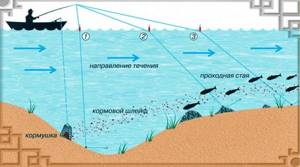
Far technique
The wisdom of this option is that the gear allows you to swim a distance of 20-30 meters. It should be noted that the initial casting distance should not exceed the length of the rod by more than twice. Long-distance fishing is preferred in water areas with strong currents and depths of no more than three meters, as well as in cases where a diligent fisherman has to fish hard-to-reach places, and casting is done in a strong tailwind.
In practice, this wiring is carried out according to the following scheme: the float is thrown to the required distance from the shore line, for some time it moves downstream to the original point of wiring. Then, by controlling the holding force of the floating float, it is forced to move along the desired trajectory.
In cases where the wind blows the float towards the fisherman, the tackle must be cast further away, and when he approaches the starting point of the retrieve, move it to the required distance with the help of a rod, controlling the strength and holding time.
Close wiring
This fishing technique is most common and is used in places with great depths and slow water movement. It depends on the influence of the wind (a vortex with the current interferes, but against it helps), and strong gusts do not allow the use of short-range guiding methods at all.
This type of bait delivery is carried out at distances ranging from 10 to 15 meters. It allows you to fish over long distances (maximum performance depends on the length of the rod used and the depths in the fishing areas). Such postings require close attention to ensure that the telescope or feeder stick is located towards the shore, and the angle between the float and the fishing line hanging from the tip of the rod relative to the angler’s location is close to 90°.
You need to get used to the process, since at first it will be difficult to keep the float on the desired trajectory. The success of fishing depends not only on the speed of the current, the number and frequency of holds, but also on the weight of the equipment. Weakly loaded tackle is harder to stop in time, but if you make it heavier, you will lose the sensitivity of bites.
Selecting a form
When choosing a fishing rod for Bolognese tackle, you must be guided by the following criteria:
- Material of manufacture.
- Length.
- Flexibility.
- Test indicators.
In the manufacture of modern fishing “telescopes”, a composite material is used from several fabric layers, which are treated with special resins. Carbon fiber models are also popular, but the previous version is characterized by increased reliability and durability, although the second is much lighter. If fishing is carried out on level ground, then it is better to use special stands for fishing rods. In this case, the impressive weight of the gear will not cause discomfort to the fisherman. After all, holding an 8-meter fiberglass lapdog throughout the entire fishing period is very problematic. Therefore, it is advisable for a beginner to purchase a carbon fiber product.
The optimal length is determined by the characteristics of the fishing location, the expected casting distance, depth and personal preferences. For beginner floaters, a 6-7-meter model will do.
The classification of Bolognese tackle mentions such an important parameter as action, which indicates the ability of the blank to bend. Depending on the intensity of this bending, it happens:
- Fast or hard action - in this case only the tip bends.
- Medium-hard - only a third of the tip can be bent.
- Middle - here the fishing rod bends from the middle.
- Slow - bending occurs along the entire length of the tackle.
It is advisable to choose light rods with a medium-hard or hard action, since they are less susceptible to all kinds of damage and are easy to control, which is important for a beginner.
If we talk about test indicators, they are selected taking into account casting distance and depth. In most cases, models with a test range of 4−20 g are used.
Choose your pass rings responsibly. It is important that they have a perfectly smooth inner surface, free of any roughness. Otherwise, the line will be suspended by friction and will quickly fray. Professional forms and products from well-known companies are equipped with rings with porcelain inserts.
Another important point is the height of the legs of the passage rings. It plays a special role in cases where there are drops of water on the form.
How to choose the right fishing spot
The most optimal thing is to prepare several promising places for fishing at once. This is motivated by the fact that if there is no bite at one point, it will be possible to move to another. The fact is that, depending on the time of year, fish can not only concentrate in certain areas of the water area, but also constantly migrate.
You need to carefully look around the reservoir, noticing the slightest anomalies. For example, you should turn your attention to a small bay among a flat coastal edge or a higher section of the coast, indicating a possible hole. Pay due attention to turns, rifts, and capes behind which a reverse current forms.
Everywhere you first need to examine the bottom topography and determine the speed of water movement. To do this, dry twigs are thrown into the water at different distances from the shore and their behavior is observed. The installation option for the equipment, including the shape of the float, will ultimately depend on this.
An equally important moment is measuring the depth and studying the topography of the reservoir’s soil. With a correct understanding of the various bumps and depressions, irregularities and obstacles, you can not only correctly configure the tackle, but also choose the composition and consistency of the bait.
To do this, you need to move the entire load to the lowest point. Its weight should slightly exceed the carrying capacity of the float. By the way, if you have an echo sounder, exploring the bottom is much easier. In this case, you can see not only any obstacles in the lower water horizon, but also be sure of the presence of fish.
Reel for rigging a Bolognese fishing rod
Installing the equipment for a Bolognese fishing rod involves finding a suitable reel. There are a number of requirements for such a fishing tool, including the following:
- The weight and size must correspond to the properties of the fishing rod.
- The spool must hold at least 100 meters of line.
- It is desirable that the selected model has a rear friction brake. This is especially important if you are going for a big trophy.
- It must have a high gear ratio.
When installing a float fishing rod, it is better to choose proven inertia-free reels, although inertial models also work well. If you know how to use the latter, then pay attention to professional tools such as “Nelma” or “Nevskaya”, which are produced by domestic companies . If you have not had to work with them, it is better to save yourself from additional problems by choosing a proven inertia-free design.
Do not rush to buy a large model, because it is not entirely comfortable to work with. It significantly disturbs the balance of the gear, which is why the fisherman quickly gets tired and the quality of the fishing decreases. The optimal reel size is determined by the length of the rod, but varies in the range of 100-4000. For a 7-8 meter blank, a 3500 size reel is perfect.
The presence of a rear clutch is a must for catching large fish. If this is exactly what you find on the hook, you can always adjust it without twisting your arms.
The minimum gear ratio of a lap dog reel starts at 5.7:1.
Most of the parameters mentioned correspond to the match reel standard, so if you have ever worked with match gear, no additional questions should arise.
Why do you need a fishing rod with a spinning reel?
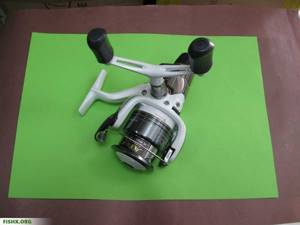
There is, after all, a spinning rod and also a new English tackle - a feeder. But, probably, more than one fisherman has encountered a situation where, for example, on a pond, a fish trail passed along a remote slope to a riverbed hole. And near the shore in the shallow water only small fish were biting.
Most ponds were formed using dams that blocked a stream or river. Meanwhile, on the old river bed, even after the flooding, there was a weak current, and the flooded river itself became a channel hole, attractive for large fish: carp, crucian carp, heavy roach, humpback perch. It was impossible to reach this riverbed edge using an ordinary float rod. And here Bolognese tackle has become a successful alternative to a fishing rod with “deaf” equipment.
Line selection
When planning to equip a lap dog, use only monofilament fluorocarbon fishing line with a cross-section of 0.14-0.22 millimeters, preferably in a bright color. If we are talking about intense sport fishing in clean, clear water, it is preferable to use a fishing line with a diameter of 0.14-0.16 mm. For amateur fishing in snags, the 0.18-0.2 mm option is suitable. If the current is too strong, the best option is a bright-colored “floating” fishing line. In a quiet body of water, the situation is completely different, because the fishing line should sink to the bottom as quickly as possible and remain invisible.
The optimal length of fishing line that needs to be wound on a reel is at least 100 meters. This amount is quite enough for a successful cast, as well as for quickly restoring the gear if damaged.
Collecting fishing gear
Fishing equipment for catching fish in a retrieve must combine not only the design and installation of equipment (rod, line, hooks, sinker, float, reel) but also knowledge of other aspects (bait, feeding). Let's take a closer look at them, since the correct design for wiring is the main tool.
Rod selection
To fish with this method, you need a rigid and at the same time light stick, for example, a telescope 4-5 meters long, equipped with rings. They make it easier to unwind the fishing line, turning the fishing process into a comfortable experience. Feeder rods have also proven themselves to be good on retrieves, and the leger type is the best. Quite tough and light, they can withstand playing large fish and do not tire your hand. The optimal length of such rods is 360-390 cm.
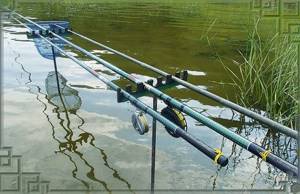
Line selection
For fishing in the wire, the tackle is equipped with a main vein 0.22-0.3 mm thick (100-150 meters), to which a leash with a fishing line diameter of 0.14-0.2 mm and a length of up to 40 cm is attached using a swivel. The equipment allows the tackle be more catchy, and in case of a snag, only the leash is lost.
Coil selection
For this fishing method, you can choose any modification depending on how comfortable it is for the fisherman to use. When you first try to learn how to catch trophy specimens using the reeling method, you can get by with inertia-free models, which are in the arsenal of all fishermen. Reels of this type are good for long, precise casting and when fishing in inconvenient places.
The advantages of coils are:
- simplicity and accuracy of casting over long distances;
- ability to quickly reel out fishing line;
- the presence of a friction brake, which reduces the number of gear breaks.

The main disadvantage is the lack of easy descent of the fishing line. Over time, you can switch to inertial types, which, when winding, prevent the veins from twisting, and when wiring, gently lower them, guaranteeing constant tension. The advantages of such reels:
- uniformity of line descent;
- absence of circles between the float and the rod on the water surface;
- ease of vein control;
- accuracy of casting into hard-to-reach places and when fishermen are crowded;
- minimal formation of “beards” when delivering bait.
To learn more:
How to make a bulldozer for grayling yourself?
Float selection
Since wire fishing is carried out in the current, the buoys must ensure the smoothest possible movement of the equipment in the fishing areas and clearly indicate the moment of the bite. Such requirements are satisfied by models attached to the fishing line at the top and bottom. Floats with a long keel (guaranteed stability in currents and strong winds) and antennas in bright colors (they are visible when casting over long distances) are suitable for use.
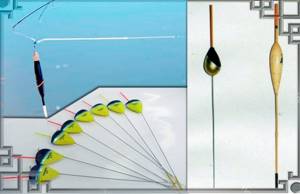
These floats are appropriate in cases where fishing by wire is carried out at depths comparable to the length of the fishing rod. In other conditions, it is appropriate to use sliding structures.
Sinker selection
The optimal installation for weighting fishing tackle is to mount several lead peas below the float. The heaviest one is placed under the bite indicator, then a smaller droplet, and the lightest one at a distance of 10-15 cm from the hook. This is the best design for cases when fishing in the current takes place.
You can also load the tackle with one sliding-type lead droplet. Such equipment is appropriate when casting over long distances. The disadvantage is low sensitivity and lack of good “play” of the nozzle.
Requirements for hooks
The Bolognese fishing rod for retrieving requires careful selection of the tip for the nozzle. Preference depends not only on the size of possible trophies, but also on the size of the bait. For example, for maggots, a point with an extended fore-end No. 12-14 would be acceptable. Accordingly, for a leech or a worm you will need a larger size. Regardless of the size and shape, the hooks must be strong and sharp in order to reliably hook the fish and not lose it during the fishing process.
Selecting a nozzle type
Maggot has proven itself to be a stable bait that works in different weather conditions for wire fishing. Based on the size of the hooks, 3-5 larvae are placed on them, piercing the edge of the head with the tip. It is advisable to hide a sting in one of the maggots.
The bloodworm proved to be no less catchy bait. But before fishing in the retrieve on the river (Oka, Buzan, Volga, Don) or other waters, you must remember that this bait is quite delicate and cannot withstand more than one cast. Bloodworms are also a very consumable bait, but as part of a “sandwich”, supplemented with maggot larvae, it promotes good results.
Directly near the fishing spot you can find burdock caterpillars, bark beetle larvae and caddis flies. Such baits work well in the spring and not only attract fish, but also give them a wild appetite. Knowing the habitats of larvae and caterpillars, you can save tens of rubles.
To learn more:
The best weather for pike fishing
Vegetable baits are also used for wire fishing. Some fish species, such as ide and roach, prefer them. At home, you can prepare pearl barley and rolled oats, boil peas and semolina porridge. Sometimes even balls of white bread crumb become a delicacy for fish.
Choice of bait
When planning to fish with a wire, it is not necessary to stock up on a large number of baits that attract fish. But it is also impossible to say that they will be superfluous. With the help of soaked bread crumbs, pearl barley grains mixed with clay and sand, you can attract a large flock. The main thing in this matter is not to overdo it and not to overfeed the object of the hunt. Otherwise, the satiated river inhabitants will stop responding to any bait.
Float Requirements
Properly equipping Bolognese tackle involves choosing a suitable float. Among the main requirements for such a product are maximum invisibility for fish and high sensitivity of bite display. In this case, the fisherman must freely see the float from a great distance.
In most cases, the Bolognese fishing rod is equipped with a sliding float, as well as a stationary model, which is effective for fishing in places where the depth is one meter less than the length of the rod. Among the existing floats, the following are widespread:
- Drop-shaped (in which the body expands downwards).
- Spindle-shaped (the upper part of these models is wider than the lower part).
- Flat.
If you are choosing a universal float, then you can use a drop-shaped model, which is effective in places with moderate currents and in standing water. As for spindle-shaped products with hollow antennas, they are useful for using different wiring techniques. In turn, flat floats with a disk-shaped working fluid located at a certain angle to the keel operate freely even in strong currents. Oblong products are used in calm water, but in currents or when playing with tackle, it is better to purchase a round bite indicator.
To improve the visibility of the float, it must be equipped with a thick and long antenna, which will be noticeable at a distance of 30 meters, allowing you to notice bites even in strong currents. The main difference between sliding products is the long keel and antenna, as well as the presence of a through hole in the body through which the main line passes.
The optimal float weight varies from 4 to 20 grams and is selected taking into account individual fishing conditions and test parameters. Some floats support variable dead weight and are recognizable by their markings.
Very often, fishermen use a sliding float for Bolognese tackle, which can be installed according to a certain pattern. The technique is particularly effective for catching crucian carp.
Models for lap dogs are available in two types:
- With single point fastening.
- With two-point fastening.
Representatives of the first group are particularly simple and reliable, so they are often used for fishing in intense currents.
Float selection
Floats used for Bolognese fishing differ in shape and method of attachment to the fishing line. Drop-shaped floats are more often used. This shape minimizes the influence of current and wind on the float. The long keel of the float ensures stability in the water when manipulating the tackle.
Read more
How to catch grass carp with a float rod?
The float antenna should be clearly visible, have neutral buoyancy and low windage.
Such a float is attached at two or three points - always near the antenna and at the end of the keel, and often at the point where the body of the float passes into the keel.
At the top point, fastening can be carried out either through a wire ring or through a through vertical hole in the body of the float. The second method is preferable, since the ring can break out if cut sharply.
In most cases, blind installation of equipment is used, fixing the float at the required depth.
Sliding installation is used in cases where the depth at the fishing spot exceeds the length of the rod.
When fishing in bodies of water without current in a sliding rig, you can use match floats. When fishing in the current, floats with two attachment points are used. The depth of immersion is limited by a locking assembly or a rubber stopper. It is important that the stopper passes freely through the guide rings of the rod.
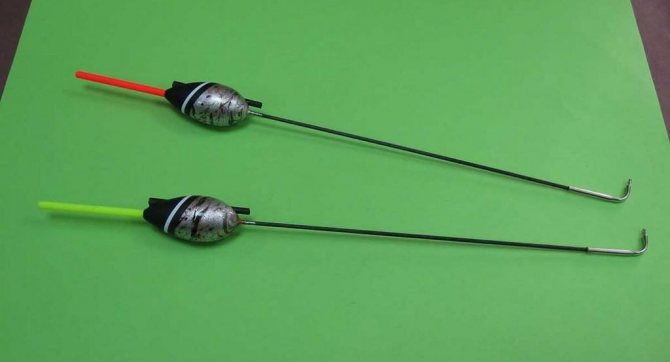
Floats for Bolognese fishing rods
Correct loading
For successful and comfortable fishing, it is important to load the lap dog correctly, using a single weight or a combined one. Here everything is determined by fishing conditions. If you are going to fish in still water, then it is advisable to use the following combination: 60% of the mass of the load is fixed directly to the float, and the remaining 40% (tiny pellets) are distributed into 2 groups at a distance of 15-20 cm.
If the current in the reservoir is not too strong, the best option would be a chain of pellets, which are located at a distance of 10-15 centimeters from each other (in descending weight) from the float to the underwater. When fishing in moderate currents, the pellets should be placed next to each other at a distance of 70 centimeters up from the float. If the current is too fast, then the best float option is a drop-shaped sliding weight, which is fixed at the bottom with the help of small pellets.
If the shipment is performed correctly, then the tackle should leave only the float antenna on the surface of the reservoir, therefore, in order to achieve the ideal balance, check the equipment at home in advance.
Bolognese fishing rod: design features

The Bolognese fishing rod is a fishing stick whose purpose is to catch fish. At the same time, the blank of such a fishing rod has a number of differences compared to a conventional float fishing rod. For example:
- The Bolognese fishing rod has a stationary reel holder.
- This type of fishing rod has guide rings at the rate of one ring per segment. The design of the rings does not allow the fishing line to stick to the blank, which makes fishing more comfortable and practical.
- The upper elbow (and sometimes two elbows), so that the load is distributed evenly, is equipped with an additional sliding wire ring.
As a rule, all models are designed as a telescopic rod and, depending on the length, consist of 4 – 8 legs. There are, but quite rarely, Bolognese rods of the plug type.
Bolognese fishing rod from A to Z (t)
Leash and hook
As a leader material, it is customary to use monofilament fishing line with a diameter of 0.12−0.14 millimeters. At the same time, the length of the leash varies and depends on the individual characteristics of the reservoir and the fishing method. For classic Bolognese tackle, 60 cm leashes are suitable. If fishing is done by wire, then a product 40 centimeters long will do.
To make fishing as effective as possible, it is better to use several different hooks that are already equipped with leashes. This will significantly simplify the process of replacing them in case you accidentally break the gear or want to change the fishing conditions. The exact size of the hook is determined by the size of the expected catch, as well as the type of bait. If you use bloodworms, maggots or small grains, then the optimal size of hooks is No. 14-No. 18. When fishing with a worm, peas or corn, it is better to choose hooks numbered 8 and 12.
Leash attachment
The purpose of the leash is to protect the tackle from breaking. Typically, leaders are used that are 0.02 mm thinner than the main line. In Bolognese fishing, leashes 20–70 cm long are used.
The length of the leash is determined experimentally. If there are a lot of empty bites, the leash is lengthened. If the fish swallows the bait deeply, shorten it. With the correct leash length, the fish should be caught by the lip.
The leash can be attached to the main line either using a swivel or loop to loop. The first method is preferable because when reeling in the rig, the nozzle often acts like a propeller and spins the line. In this case, the smaller the swivel used, the better.
Read more
How to make a float with your own hands?
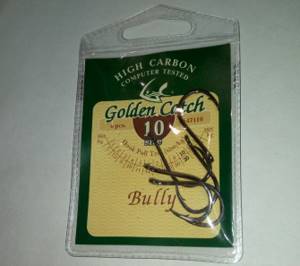
Fishing hooks Golden Catch Bully No. 10
Fishing with a Bolognese fishing rod, choosing a fishing location
Before looking for a fishing spot, you need to study the habits of the fish you are going to hunt, what kind of bottom topography it likes, at what depth it stands, feeds from the bottom or in the water column, and based on this, choose areas for fishing.
In the spring you need to fish on small rivers and bays, since all the fish rush there for spawning. After spawning, it should be looked for at the mouth of the river, and in the summer in wide rivers and reservoirs. On lakes, before spawning, it stands at depth, during spawning in shallow water, and after spawning, when the heat sets in, it returns to a depth of 2-4 m.
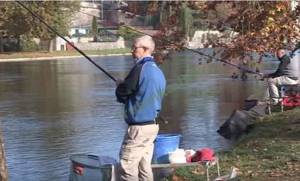
When fishing on a fast river, you need to look for areas where the current is weakened. When fishing on a river with a medium current, you need to pay attention to places where there is no current or, on the contrary, a stronger one. Quite promising fishing spots are areas where the river narrows, washed-out banks, riffles, whirlpools, and tree crowns hanging over the water.
It is also worth paying attention to the presence of vegetation in the fishing area, since the Bolognese rod is 6-7 meters long, and it will be inconvenient for you to fish under the canopy of trees.
